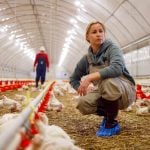The starting point for assessing a feedlot’s nutrition and feeding program is documentation about the feeding program along with feed records, either on a computer or hard copy.
Ten points are awarded for working with a nutritionist and/or veterinarian to ensure rations meet requirements for all classes of cattle, along with two points for each of the following criteria to be included in the feeding program information:
- How and when to transition cattle from high-forage to high-energy rations (step-up program) to avoid abrupt dietary changes, and other management strategies to reduce the risk of bloat and grain overload.
- The percentage of forage/fibre (silage, hay, straw) in high-energy rations to avoid digestive disorders. (Awaiting National Research Council recommendations for minimum fibre requirements in finishing feedlot rations; some nutritionists recommend at least five per cent forage on a dry-matter basis.)
- Actions taken during feed interruptions, such as storms, power outages, mill or truck breakdowns, or a sudden major ingredient change, and how rations are adjusted when feeding resumes.
- How to monitor cattle behaviour, performance, body condition score and health, and adjust rations accordingly.
- How to assess water quality and quantity and adjust as needed.
Read Also

Alberta ranch family outlasts droughts
Over the years, the Lehr family has learned a thing or two about managing the ranch through dry years
An explanation of how readily accessible and sufficient feed and water is provided non-ambulatory (downer) animals is worth an additional 10 points.
Feed records, awarded two points, can be daily feed call and delivery sheets, batch mix sheets, and veterinary feed prescriptions. These documents are required under the Canadian Food Inspection Agency’s Feed Act and Regulations.
Another two points for measures such as inspection of incoming feed and feed tests to prevent exposure to toxins and feed with adverse physical qualities.
Five points are awarded for monitoring feed bunks daily for consumption and adjusting feeding accordingly, taking into account weather changes.
Training for feeding staff is worth five points with records on the training program worth an additional two points.
Pen environment
Even with a well-managed feeding program, animal performance will lag if cattle have to struggle through mud and/or manure to get to the bunk and water bowl and don’t have enough space to rest comfortably.
Additionally, excessively muddy pens not only increase the risk of lameness caused by footrot and hairy heel warts, but make it difficult for pen riders to identify and pull lame cattle and cattle with other ailments. Manure also generates enormous amounts of heat during summer, in turn increasing the risk of heat stress in cattle.
A pen is scored as being muddy if mud is more than four inches over the fetlock (about 12 inches above the sole of the hoof), across more than one-third of the pen floor area, not including the bedding pack, feed bunk and water trough areas.
The stocking density in each pen should allow enough useable space for all animals to lie down to rest at the same time.
Auditors will walk through pens to assess their condition. They are advised to select a representative sample of feeding pens from several alleys and locations along the alleys, also trying to select pens of cattle of differing classes and stages in the feeding program. At least 10 per cent of the total number of feeding pens should be observed along with one receiving pen, one shipping pen, up to two sick pens, one chronic pen and one rail pen after pen riders have checked, pulled and treated sick cattle for the day.
The number of animals in each of the selected pens that are in poor body condition, injured, lame, down, dead or have excessive tag will be marked on the score sheet. In sick and chronic pens, the auditor only notes animals that are very sick and in obvious distress (mouth breathing because of severe or chronic respiratory disease, severe congestive heart failure, severely dehydrated, non-ambulatory, severely lame and unable to rise unassisted, large open draining infected wounds, emaciated).
Each of the selected pens is scored on mud conditions and stocking density, as well as feed and water quality. Remember — not providing feed within a 24-hour period and not providing water at all times in feeding pens are considered egregious acts of neglect and cause for audit failure.
The point system, if targets are met, is as follows:
- Muddy pens: target ≤30% — as described above — 5 points
- Overstocked pens: target ≤10% — as described above — 10 points
- No feed: target 0% — feed must have been provided within the 24-hour period — 10 points
- Poor quality feed: target ≤10% — mouldy, frozen, contaminated with rocks, manure, snow — 5 points
- No water: target 0% — water must be available in feeding pens at all times — 10 points
- Poor quality water: — frozen, hot, sludgy — target 0%: 5 points.
This is part of a series of articles on the new Canadian Feedlot Animal Care Assessment Program. For more information, contact your provincial cattle feeder association for the link to all program documents on the Nation Cattle Feeders Association’s website, or contact the NCFA, 403-769-1519, [email protected].

















